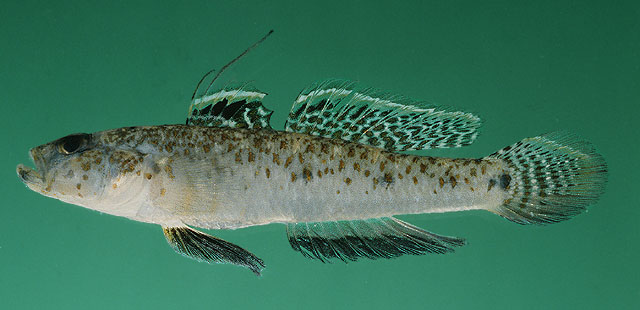| Gobiidae (Gobies), subfamily: Gobiinae |
| 8.3 cm TL (male/unsexed) |
|
demersal; depth range 0 - 5 m, amphidromous |
| Indo-West Pacific: East Africa to the Philippines (Ref. 7050), north to Japan (Ref. 559), south to northern Australia (Ref. 33390). |
|
Dorsal spines (total): 7-7; Dorsal soft rays (total): 8-8; Anal spines: 1-1; Anal soft rays: 7-8. Body with small spots; sides with 4-5 groups of black spots, last spot on caudal peduncle often paired without a vertical bar at caudal base; median fins spotted; paired fins pale (Ref. 2798). Large males with dusky 1st dorsal, anal and pelvic fins (Ref. 2798); characterized further by second dorsal spine forming elongate, threadlike filament; pelvic fins united medially; presence of pelvic frenum; rounded caudal fin; longitudinal scale series 27; ctenoid scales except cycloid on breast and pectoral fin base; predorsal scales 3, scale absent on remainder of head; depth of body 6.1 in SL (Ref. 90102). |
| Usually in small groups (Ref. 90102). Found over sandy and muddy bottoms, often in weedy areas of intertidal zone; also in mangroves, estuaries, lagoons and rivers (Ref. 4343). |
|
(Ref. 96402)
|
| harmless |
|
Source and more info: www.fishbase.org. For personal, classroom, and other internal use only. Not for publication.
Page created by Jen, 05.08.02,
php script by kbanasihan 06/09/2010 ,
last modified by
dsantos, 20/08/10

